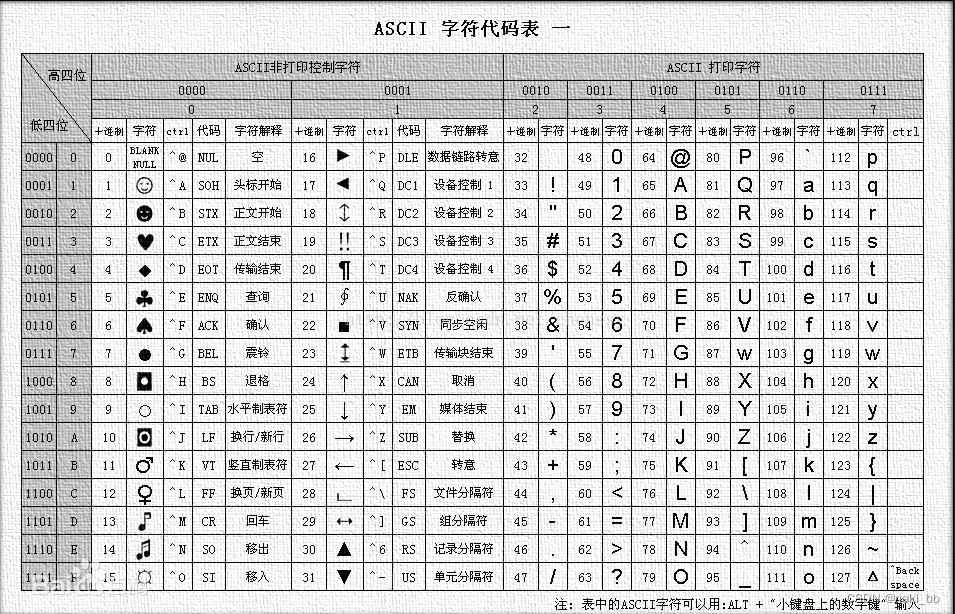字符集
常见字符集:
- ASCII 字符集
ASCII(American Standard Code for Information Interchange,美国信息交换码):包含数字、英文、符号
- GBK字符集
GBK是中国的码表,包含了几万个汉字字符,同时也要兼容ASCII编码
GBK编码中一个中文字符一般以两个字节存储 - Unicode(UTF-8)字符集等
统一码,也叫万国码。是计算机科学领域里的一项业界标准
UTF-8是Unicode的一种常见编码方式
UTF-8编码后一个中文一般以三个字节的形式存储,同时兼容ASCII编码表
1. 常见字符集 底层字符的编码是什么样的?
- 英文和数字等在任何国家的字符集中都占1个字节
- GBK字符中一个中文字符占2个字节
- UTF-8编码中一个中文1般占3个字节
2. 编码前的字符集和解码时的字符集有什么要求?
- 必须一致,否则会出现字符乱码
- 英文和数字不会乱码
普通字节流
FileInputStream & FileOutputStream
public class Test {
public static void main(String[] args) {
try (
// 这里面只能放置资源对象,用完会自动关闭:自动调用资源对象的close方法关闭资源(即使出现异常也会做关闭操作)
// 1、创建一个字节输入流管道与原视频接通
InputStream is = new FileInputStream("file-io-app/src/out04.txt");
// 2、创建一个字节输出流管道与目标文件接通
OutputStream os = new FileOutputStream("file-io-app/src/out05.txt");
// int age = 23; // 这里只能放资源
MyConnection connection = new MyConnection(); // 最终会自动调用资源的close方法
) {
// 3、定义一个字节数组转移数据
byte[] buffer = new byte[1024];
int len; // 记录每次读取的字节数。
while ((len = is.read(buffer)) != -1) {
os.write(buffer, 0, len);
}
System.out.println("复制完成了!");
} catch (Exception e) {
e.printStackTrace();
}
}
}
class MyConnection implements AutoCloseable {
@Override
public void close() throws IOException {
System.out.println("连接资源被成功释放了!");
}
}普通字符流
FileReader & FileWriter
public static void main(String[] args) throws Exception {
// 1、创建一个文件字符输入流与源文件接通
Reader fr = new FileReader("file-io-app/src/data07.txt");
// 2、用循环,每次读取一个字符数组的数据。 1024 + 1024 + 8
char[] buffer = new char[1024]; // 1K字符
int len;
while ((len = fr.read(buffer)) != -1) {
String rs = new String(buffer, 0, len);
System.out.print(rs);
}
}
public static void main(String[] args) throws Exception {
// 1、创建一个字符输出流管道与目标文件接通
// Writer fw = new FileWriter("file-io-app/src/out08.txt"); // 覆盖管道,每次启动都会清空文件之前的数据
Writer fw = new FileWriter("file-io-app/src/out08.txt", true); // 覆盖管道,每次启动都会清空文件之前的数据
fw.write(98);
fw.write('a');
fw.write('徐'); // 不会出问题了
fw.write("\r\n"); // 换行
// b.public void write(String c)写一个字符串出去
fw.write("abc我是中国人");
fw.write("\r\n"); // 换行
// c.public void write(char[] buffer):写一个字符数组出去
char[] chars = "abc我是中国人".toCharArray();
fw.write(chars);
fw.write("\r\n"); // 换行
// d.public void write(String c ,int pos ,int len):写字符串的一部分出去
fw.write("abc我是中国人", 0, 5);
fw.write("\r\n"); // 换行
// e.public void write(char[] buffer ,int pos ,int len):写字符数组的一部分出去
fw.write(chars, 3, 5);
fw.write("\r\n"); // 换行
// fw.flush();// 刷新后流可以继续使用
fw.close(); // 关闭包含刷线,关闭后流不能使用
}
缓冲字节流
BufferedInputStream & BufferedOutputStream
public static void main(String[] args) {
try (
// 这里面只能放置资源对象,用完会自动关闭:自动调用资源对象的close方法关闭资源(即使出现异常也会做关闭操作)
// 1、创建一个字节输入流管道与原视频接通
InputStream is = new FileInputStream("D:\\resources\\newmeinv.jpeg");
// a.把原始的字节输入流包装成高级的缓冲字节输入流
InputStream bis = new BufferedInputStream(is);
// 2、创建一个字节输出流管道与目标文件接通
OutputStream os = new FileOutputStream("D:\\resources\\newmeinv222.jpeg");
// b.把字节输出流管道包装成高级的缓冲字节输出流管道
OutputStream bos = new BufferedOutputStream(os);
) {
// 3、定义一个字节数组转移数据
byte[] buffer = new byte[1024];
int len; // 记录每次读取的字节数。
while ((len = bis.read(buffer)) != -1){
bos.write(buffer, 0 , len);
}
System.out.println("复制完成了!");
} catch (Exception e){
e.printStackTrace();
}
}缓冲字符流
BufferedReader & BufferedWriter
public static void main(String[] args) {
try(
// 1、创建缓冲字符输入流管道与源文件接通
BufferedReader br = new BufferedReader(new FileReader("io-app2/src/csb.txt"));
// 5、定义缓冲字符输出管道与目标文件接通
BufferedWriter bw = new BufferedWriter(new FileWriter("io-app2/src/new.txt"));
) {
// 2、定义一个List集合存储每行内容
List<String> data = new ArrayList<>();
// 3、定义循环,按照行读取文章
String line;
while ((line = br.readLine()) != null){
data.add(line);
}
System.out.println(data);
// 4、排序
// 自定义排序规则
List<String> sizes = new ArrayList<>();
Collections.addAll(sizes, "一","二","三","四","五","陆","柒","八","九","十","十一");
Collections.sort(data, new Comparator<String>() {
@Override
public int compare(String o1, String o2) {
// o1 八.,....
// o2 柒.,....
return sizes.indexOf(o1.substring(0, o1.indexOf(".")))
- sizes.indexOf(o2.substring(0, o2.indexOf(".")));
}
});
System.out.println(data);
// 6、遍历集合中的每行文章写出去,且要换行
for (String datum : data) {
bw.write(datum);
bw.newLine(); // 换行
}
} catch (Exception e) {
e.printStackTrace();
}
}字符转换流
当读取固定字符集,或者输出为固定字符集时
public static void main(String[] args) throws Exception {
// 代码UTF-8 文件 GBK "D:\\resources\\data.txt"
// 1、提取GBK文件的原始字节流。 abc 我
// ooo oo
InputStream is = new FileInputStream("D:\\resources\\data.txt");
// 2、把原始字节流转换成字符输入流
// Reader isr = new InputStreamReader(is); // 默认以UTF-8的方式转换成字符流。 还是会乱码的 跟直接使用FileReader是一样的
Reader isr = new InputStreamReader(is , "GBK"); // 以指定的GBK编码转换成字符输入流 完美的解决了乱码问题
BufferedReader br = new BufferedReader(isr);
String line;
while ((line = br.readLine()) != null){
System.out.println(line);
}
}
public static void main(String[] args) throws Exception {
// 1、定义一个字节输出流
OutputStream os = new FileOutputStream("io-app2/src/out03.txt");
// 2、把原始的字节输出流转换成字符输出流
// Writer osw = new OutputStreamWriter(os); // 以默认的UTF-8写字符出去 跟直接写FileWriter一样
Writer osw = new OutputStreamWriter(os , "GBK"); // 指定GBK的方式写字符出去
// 3、把低级的字符输出流包装成高级的缓冲字符输出流。
BufferedWriter bw = new BufferedWriter(osw);
bw.write("我爱中国1~~");
bw.write("我爱中国2~~");
bw.write("我爱中国3~~");
bw.close();
}对象输入输出流
将对象写入到磁盘,或者从磁盘读取到内存。需要对象实现序列化
public static void main(String[] args) throws Exception {
// 1、创建学生对象
Student s = new Student("陈磊", "chenlei","1314520", 21);
// 2、对象序列化:使用对象字节输出流包装字节输出流管道
ObjectOutputStream oos = new ObjectOutputStream(new FileOutputStream("io-app2/src/obj.txt"));
// 3、直接调用序列化方法
oos.writeObject(s);
// 4、释放资源
oos.close();
System.out.println("序列化完成了~~");
}
public static void main(String[] args) throws Exception {
// 1、创建对象字节输入流管道包装低级的字节输入流管道
ObjectInputStream is = new ObjectInputStream(new FileInputStream("io-app2/src/obj.txt"));
// 2、调用对象字节输入流的反序列化方法
Student s = (Student) is.readObject();
System.out.println(s);
}
序列化的版本需要和反序列时一致,否则报错
打印流
PrintStream & PrintWriter
作用:可以方便、高效打印数据到文件中去,例如直接打印整性,Boolean,都可以直接写入流
- 打印数据功能上是一模一样的,都是使用方便,性能高效(核心优势)
- PrintStream继承自字节输出流OutputStream,支持写字节数据的方法。
- PrintWriter继承自字符输出流Writer,支持写字符数据出去。
public static void main(String[] args) throws Exception {
// 1、创建一个打印流对象
// PrintStream ps = new PrintStream(new FileOutputStream("io-app2/src/ps.txt"));
// PrintStream ps = new PrintStream(new FileOutputStream("io-app2/src/ps.txt" , true)); // 追加数据,在低级管道后面加True
// PrintStream ps = new PrintStream("io-app2/src/ps.txt" );
PrintWriter ps = new PrintWriter("io-app2/src/ps.txt"); // 打印功能上与PrintStream的使用没有区别
ps.println(97);
ps.println('a');
ps.println(23.3);
ps.println(true);
ps.println("我是打印流输出的,我是啥就打印啥");
ps.close();
}Properties
public static void main(String[] args) throws Exception {
// 需求:使用Properties把键值对信息存入到属性文件中去。
Properties properties = new Properties();
properties.setProperty("admin", "123456");
properties.setProperty("dlei", "003197");
properties.setProperty("heima", "itcast");
System.out.println(properties);
/**
参数一:保存管道 字符输出流管道
参数二:保存心得
*/
properties.store(new FileWriter("io-app2/src/users.properties")
, "this is users!! i am very happy! give me 100!");
}
public static void main(String[] args) throws Exception {
// 需求:Properties读取属性文件中的键值对信息。(读取)
Properties properties = new Properties();
System.out.println(properties);
// 加载属性文件中的键值对数据到属性对象properties中去
properties.load(new FileReader("io-app2/src/users.properties"));
System.out.println(properties);
String rs = properties.getProperty("dlei");
System.out.println(rs);
String rs1 = properties.getProperty("admin");
System.out.println(rs1);
}Commons-IO
简单的API说明
public static void main(String[] args) throws Exception {
// // 1.完成文件复制!
IOUtils.copy(new FileInputStream("D:\\resources\\hushui.jpeg"),
new FileOutputStream("D:\\resources\\hushui2.jpeg"));
// // 2.完成文件复制到某个文件夹下!
FileUtils.copyFileToDirectory(new File("D:\\resources\\hushui.jpeg"), new File("D:/"));
// 3.完成文件夹复制到某个文件夹下--包含子目录文件!
FileUtils.copyDirectoryToDirectory(new File("D:\\resources") , new File("D:\\new"));
FileUtils.deleteDirectory(new File("D:\\new"));
//删除文件夹包含子文件,目录
FileUtils.deleteDirectory(new File("D:\\new"));
}更多API,可以参考























 1231
1231











 被折叠的 条评论
为什么被折叠?
被折叠的 条评论
为什么被折叠?








